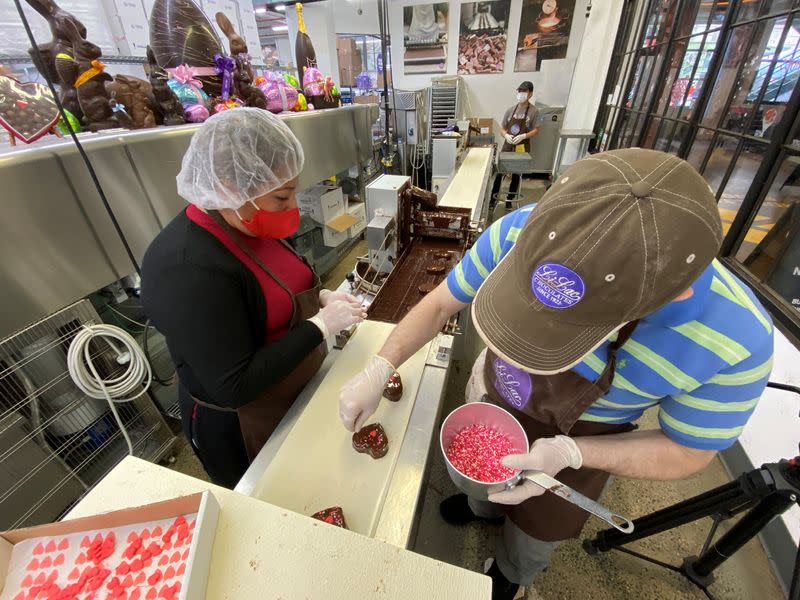Strong US worker productivity keeps labor costs in check in fourth quarter

By Lucia Mutikani
WASHINGTON (Reuters) - U.S. worker productivity grew faster than expected in the fourth quarter, keeping unit labor costs contained and giving the Federal Reserve another boost in the fight against inflation.
Labor market momentum is also fading, though gradually, which could further help to curb wage inflation. First-time applications for unemployment benefits rose to a two-month high last week, other data from the Labor Department showed on Thursday. The number of people on unemployment rolls was also the highest in two months.
The reports followed news on Wednesday that compensation costs rose in the fourth quarter at the slowest pace since 2021.
The U.S. central bank left interest rates unchanged on Wednesday. Fed Chair Jerome Powell offered a sweeping endorsement of the economy's strength, telling reporters that interest rates had peaked and would move lower in coming months.
"Inflation is increasingly coming back under control as the economy is more productive, keeping labor costs in check, and the labor market is rebalancing," said Christopher Rupkey, chief economist at FWDBONDS in New York. "This is what Fed officials are looking for in order to deliver the interest rate cuts the market is clamoring for later on this year."
Nonfarm productivity, which measures hourly output per worker, increased at a 3.2% annualized rate last quarter, the Labor Department's Bureau of Labor Statistics said. Data for the third quarter was revised lower to show productivity growing at a still-solid 4.9% rate instead of the previously reported 5.2%.
Economists polled by Reuters had forecast productivity increasing at a 2.5% rate. Productivity expanded at a 2.7% pace from a year ago. Productivity growth averaged 1.2% in 2023 after contracting 1.9% in 2022.
Since the fourth quarter of 2019, labor productivity has grown at an annual rate of 1.6%, 0.1-percentage point above the pace during the previous business cycle, which ran from the fourth quarter of 2007 through the fourth quarter of 2019. It is below its long-term rate of 2.1%
The economy grew at a 3.3% rate in the fourth quarter.
Financial markets and most economists expect the Fed will start cutting rates in May. Stocks on Wall Street were trading higher. The dollar advanced versus a basket of currencies. U.S. Treasury prices rose.
LABOR MARKET EASING
Unit labor costs - the price of labor per single unit of output - rebounded at a 0.5% rate last quarter after declining at a 1.1% pace in the July-September quarter.
They rose at a 2.3% rate from a year ago. Growth in unit labor costs averaged 2.9% in 2023, slowing from 5.6% in 2022.
Hourly compensation increased at a 3.7% pace last quarter. It rose at a 5.0% rate from a year ago. Hourly compensation gains averaged 4.2% in 2023, up from 3.7% in 2022.
The moderation in labor costs pushes the Fed closer to bringing inflation down to its 2% target. The central bank has raised its policy rate by 525 basis points since March 2022 to the current 5.25%-5.50% range.
In separate report on Thursday, the Labor Department said initial claims for state unemployment benefits increased 9,000 to a seasonally adjusted 224,000 for the week ended Jan. 27, the highest level since November.
Economists had forecast 212,000 claims for the latest week. Claims remain low by historical norms.
Unadjusted claims rose 11,082 to 261,029 amid large increases in California, New York and Oregon. These more than offset notable decreases in Illinois and Missouri.
The claims report also showed that the number of people receiving benefits after an initial week of aid, a proxy for hiring, increased 70,000 to 1.898 million during the week ending Jan. 20, also the highest level since November.
Despite the rise in claims, most employers are holding on to their workers following difficulties finding labor during and after the COVID-19 pandemic. But some companies, which enjoyed a boom in business during the pandemic are laying off workers as conditions revert back to normal. The United Parcel Service said this week it planned to cut 12,000 jobs.
A third report from global outplacement firm Challenger, Gray & Christmas on Thursday showed U.S.-based employers announced 82,307 job cuts in January, a 136% jump from December. Layoffs were, however, down 20% compared to January 2023.
Some economists were not perturbed by the surge in job cuts, with JPMorgan's Daniel Silver noting that "these figures are not seasonally adjusted and layoff announcements usually increase between December and January."
The claims data have no bearing on January's employment report, scheduled to be released on Friday.
Nonfarm payrolls likely increased by 180,000 jobs last month, according to a Reuters survey of economists. The economy added 216,000 positions in December. The unemployment rate is forecast rising to 3.8% from 3.7% in December.
The labor market is shielding the economy from recession, by supporting consumer spending and demand for housing. A fourth report from the Commerce Department's Census Bureau showed construction spending increased 0.9% in December, buoyed by a 1.6% jump in outlays on new single-family projects.
Solid demand for goods left manufacturing on the verge of recovery in January, a fifth report from the Institute for Supply Management showed. Comments from manufacturers varied from "good start to the year," to "demand continues to be slow."
"We are not out of the woods, but even the beleaguered factory sector is shaking off the gloomy recession vibes," said Shannon Seery Grein, an economist at Wells Fargo in Charlotte, North Carolina.
(Reporting by Lucia Mutikani; Editing by Chizu Nomiyama and Andrea Ricci)